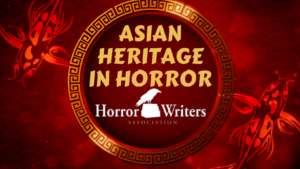Asian Heritage in Horror: Introduction by Lee Murray


Lee Murray is an author, editor, screenwriter, and poet from Aotearoa-New Zealand. A USA Today Bestselling author, double Bram Stoker, and Shirley Jackson Award winner, her work includes military thrillers, the Taine McKenna Adventures, supernatural crime-noir series The Path of Ra (with Dan Rabarts), and short fiction collection, Grotesque: Monster Stories. Lee is the curator-editor of eighteen volumes of dark fiction, among them Black Cranes: Tales of Unquiet Women (with Geneve Flynn). Lee’s first poetry collection, Tortured Willows, a collaboration with Angela Yuriko Smith, Christina Sng and Geneve Flynn was released in October 2021. Read more at https://www.leemurray.info/
Introduction
The Xiāng-Liǔ is a monster of Asian myth. A voracious nine-headed serpent, this terrifying venomous creature appears in the historical and mythological text Classics of Mountains and Seas. It’s a powerful image and a good metaphor for the diversity of Asian voices in our horror community.
Asian horror hails not only from indigenous writers but also from myriad people of the diaspora, those living beyond Asia in other countries. We have writers of Malay heritage living and working in Australia, for example. There are Chinese writers raised in Scotland, Uchinanchu in America, Japanese-heritage writers based in Canada, and Indian writers in England. We have creatives from Korea, Singapore, Laos, Taiwan, and the Philippines. And these represent just some of those who claim Asian heritage in our HWA horror family.
Asian horror is a multi-headed creature, hungry to tell its stories, each head of the serpent with its own unique and important voice, each bringing old lore and fresh perspectives to the horror genre. Asian writers are addressing such vital topics as gender, tradition, racism, poverty, war, and oppression. Asian horror stories tell of terror, and also of triumph, from epic adventure to ethereal ghost tales to quiet suffering. As rich and vibrant as they are chilling, Asian stories always present a challenge, told as they are at the intersection of cultures, languages, landscapes, and generations. Asian horror is complex and compelling.
The Xiāng-Liǔ serpent-myth arose from true accounts of a dreadful historic flood that plagued China for many years, and this is fitting too, as in recent years we have seen a groundswell in Asian voices in horror, rising from a tiny trickle to a steady current. Asian creatives are represented throughout horror’s subgenres, including, but not limited to, short fiction, long fiction, novel, poetry, graphic novel, and film. It’s an exciting time to be a horror writer of Asian heritage, since horror is a subversive and inclusive genre, and our community welcomes even the strangest monsters.
Over the coming weeks, the HWA is honouring Asian Heritage Month with a variety of interviews and articles to highlight and celebrate our Asian horror creatives. I am hoping for a deluge of voices, lifted together on the neck of the mythological monster Xiāng-Liǔ. Each individual serpent head reaching out through genre to stab at us with their venomous darkness. To inject our veins with fears that will rock us to the very core. Please take a moment to discover some of the serpent’s varied and exciting voices and recommend them to your friends.



